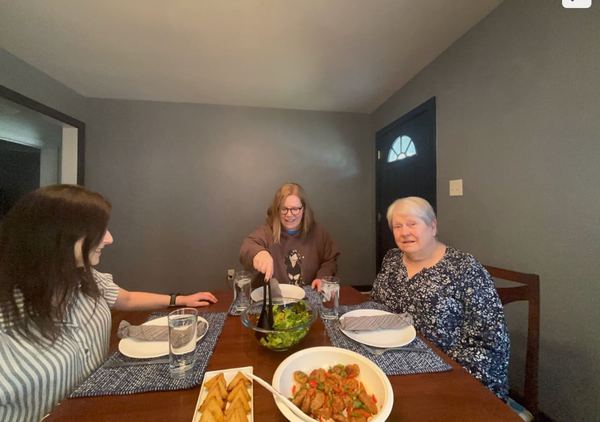Instigating 101: How Sophia & Joel started "The Neighbormune"
Sophia and Joel took the initiative in their friend group to purchase a duplex and bring other people into their vision of living near friends. At Live Near Friends, we call people like them "the instigators." Here’s how they created “The Neighbormune,” and their advice for others who want to do something similar.

The basics:
Location: Fort Collins, CO
# of friends: 8
The instigators: Sophia and Joel
The setup: One duplex (owned), one apartment next door (rented), one garage with ADU potential (future expansion)
Creating the Neighbormune
Soon after they got married, Sophia and Joel started dreaming about buying a house where they could live among friends. They hoped to find something that brought their friends together while still providing separate living space for everyone, and prepared themselves for a long and arduous search for a unicorn property.
As it turned out, they fell in love with the very first property they toured, a spacious duplex with a large garage within biking distance of downtown Fort Collins. Two months later, six friends moved in—four in the upstairs unit, and two downstairs. When the apartment next door came up for rent the following year, Sophia’s two sisters and one of their partners moved in.
If it sounds like it came together easily, that’s because it did. “It felt like fate,” Sophia said. They’ve spent the past three years there, enjoying a sense of easy proximity to their favorite people. “None of us live near our parents,” Joel said, “so we’re each other’s main support structure.”
If there’s one key takeaway from their story, it’s the power of being an instigator in your friend group. Joel and Sophia wanted to do something that felt impossible, but once they started, it seemed to come together almost like magic. But it wasn’t magic: it was simply what happens when someone takes the lead within their friend group.
How to be an effective instigator:
Step #1: Articulate your vision
During college, Joel loved living “crammed together in one house with a bunch of friends from the climbing community.” Most people take it for granted that after they graduate, their friend groups will naturally disperse. Not Joel. He’s a social scientist who studies trust and social cohesion, and his research shaped his vision and priorities for life. “What do happy people do around the world?” he asked. “Usually they live around their friends or have a lot of close relationships in the community.”
Joel decided that he would find a way to continue living near his friends throughout adult life. When he and Sophia got married, they started scheming about ways to make it possible for the long term.
Having a clear understanding of what they wanted for themselves and why made Joel and Sophia more effective communicators when it came time to recruit their friends into their vision.
Step #2: Rally your friends
Most successful Live Near Friends projects we see start with an instigator or two who drive the vision. Sophia and Joel were well positioned to play this role.
Well before they formed the Neighbormune, Sophia and Joel acted as the glue for their social group, constantly organizing ways for their friends to socialize. Between regular potlucks, dinners, and coffee shop hangouts, the same rotating cast of characters got together in person around three times per week.
“If you want to find out who will want to live with you, start organizing ways to have a constant high touch of seeing those people,” Sophia said. That way, when they started floating the idea of coordinating their living situations, the high baseline level of comfort and familiarity made the conversation feel natural.
In addition to these conversations, they sent their friends case studies of friends living near each other to help flesh out what living together might look like.
Before they started looking for a house, Joel and Sophia had a final conversation with their friends to make sure they’d be on board should they find a good place. They painted a picture of how they imagined their living situation: shared gardening projects, potlucks, and movie nights. Their friends were enthusiastic collaborators, and suggested chickens and an outdoor eating area. Everyone felt excited about the plan.
Once they knew their friends were interested, Sophia and Joel elected themselves as leaders of the process. “We didn’t wait for our friends to all come to a collective agreement,” Joel said. “We just took on the project ourselves, and made it easy for others to come along.”
Step #3: Decide on a financial structure
Joel and Sophia were interested in the idea of going in on a duplex with their friends as co-owners, but none of their friends, who were mostly artists and musicians, could afford it. As the most professionally stable ones in their group, Joel and Sophia had the means to purchase a property on their own, so they checked their friends’ comfort level with a landlord-tenant setup.
These conversations were casual and direct. “We just asked them, ‘Would you be down to live in a unit with us as your landlords?’” Sophia said. “‘We know it might seem a little weird but we think it will be worth it.’”
Once they had a commitment from Joel’s two best friends, they knew they were able to pay the mortgage on a multi-unit building and they felt comfortable moving forward with the project as sole owners.
When it came time to draw up lease agreements, Joel and Sophia offered their friends below-market rents. “We didn’t go into this to be landlords,” Sophia said. “We were willing to almost bribe our friends to come along with us.” In the end, everyone ended up benefiting, both by getting to live together and by having a more affordable rent/mortgage than the alternative.
Joel and Sophia are interested in exploring co-ownership models in the future. They’re thinking about having children soon, and co-ownership seems like a good way to provide a sense of stability and commitment among the participants. But one major benefit of the landlord tenant model was that, without additional owners to coordinate with, they could continue operating as primary decision makers and drive the process forward quickly.
Step #4: Find the right property
Proposing a specific location is a critical step in bringing your vision from dream to reality.
With a clear financial structure in mind, Sophia and Joel could start making more detailed plans. They got pre-approval for a loan, came up with a target price range, and started researching the market in their area. This allowed them to narrow their search to duplexes or large homes that could be cordoned off for multiple inhabitants.
Then they got lucky: the first house they toured was perfect for them. It was a duplex with two private units – the top one for Joel and Sophia and the bottom ones for friends.
Constraints around zoning and occupancy limits created a bit of a headache, but they eventually sorted things out. “That’s why Live Near Friends is great,” Joel said. “If you can find a few separate apartments or houses next to each other, you don’t have to deal with any of that.”
Step five: Grow incrementally
Joel and Sophia had dreamed about buying a few acres of land and building homes with all their closest friends. But starting something at that scale requires the stars to align in many different areas all at once:
- Lots of friends would need to be ready to join the vision at the same time
- They’d need to find a rare property to meet their needs
- They’d need to raise a large amount of money
Cognizant of these challenges, Sophia and Joel decided to take an incremental approach. They didn’t let their grand vision block progress on their starter project of simply buying a duplex.
And it turns out that when a couple of friends are living their best lives near each other, it’s easy to attract more. A year after they moved in, the apartment next door came up for rent, and Sophia’s two sisters were quick to jump on the opportunity. Now they’re exploring the possibility of converting the garage into a separate living unit.
You can do this too.
Joel and Sophia didn’t end up in their living situation by chance. It was an outcome they dreamed of, planned for, and executed on. By demystifying the path they took to get where they are now, we hope to make it easier for others to follow in their footsteps—and to demonstrate that living near your friends isn’t something you have to give up as part of being an adult.
It takes some initial effort and coordination to make it happen, but in Joel and Sophia’s case, they were surprised by how seamlessly it came together once they started working on it—and by how dramatically it has paid off.
Are you the instigator in your friend group? Check out livenearfriends.com to help you coordinate your people and start looking for housing





